
autumn 2025












autumn 2025










Artificial Intelligence (AI). You’ve probably heard of it. It’s everywhere, sparking conversations, raising questions, and shaping the future at an extraordinary pace. But what does intelligence really mean?
By definition, intelligence is “the ability to acquire and apply knowledge and skills.” It’s not just about memorising facts or solving equations; intelligence takes many forms. Howard Gardner’s theory of multiple intelligences reminds us that people learn, think, and express themselves in diverse ways. Some excel in logical reasoning, while others shine in music, sport, or interpersonal connections. At St Margaret’s College, we see this every day – in the student who crafts a compelling speech, the one who engineers a robotic solution, the artist who brings emotion to a canvas, or the leader who uplifts her peers. Across all ages, I never cease to be amazed by the glorious intelligence of our girls. There is no doubt that the AI revolution is here, and it will continue to evolve. AI can analyse data, compose music, and even generate artwork. But there are things AI will never do. It cannot show empathy, express true creativity,

share emotional intelligence, offer compassion, or make ethical decisions. These are the uniquely human qualities that set us apart. And these are the qualities that matter most.
As our girls navigate a world increasingly shaped by technology, what will truly define them is not just their academic achievements but their kindness, curiosity, courage, and care for others. AI might be able to process information faster, but it will never replace the warmth of a reassuring word, the depth of a meaningful conversation, or the strength of human connection.
The world is changing too quickly for anyone to learn everything they need to know while they’re in school. What matters most is knowing how to learn, how to think critically, and how to be a good, authentic person.
You can read more about St Margaret’s human centred approach on page 8, reminding us that our students are not just preparing for an AI-driven future, they are shaping it with true intelligence that goes beyond machines.
Diana Patchett, Executive Principal


For more than a century, our Old Girls’ Association has fostered lifelong connections, ensuring that the spirit of St Margaret’s extends well beyond our school years. From its very first event in 1914 – a dance for Upper School girls, since evolved into the Leavers’ Ball for Year 13 students and their families– to its ongoing support of the College today, our alumnae association remains central to our College’s story.
Our alumnae play an important role in shaping the futures of St Margaret’s current students, returning to share their expertise and experience through career events, mentoring, and networking initiatives. This year, we are excited to introduce new initiatives, including Lunch Bytes, a series of inspiring talks for students led by recent alumnae, and an upcoming investment seminar for students and their families designed to provide valuable financial insights from industry professionals. These initiatives reflect the strong commitment of our alumnae to empower current students to learn, live, and lead.
The impact of our alumnae and their generous support of the College can also be seen across the campus, from the Old Girls’ Atrium, to the cherished St Mark’s Chapel, to the artwork, photography and memorabilia displayed around the school in celebration of our shared history.
The legacy of our Old Girls is deeply embedded in the fabric of St Margaret’s, with another cohort of daughters, granddaughters, nieces and great-nieces of our Old Girls joining the College this year, and several former students serving on staff.
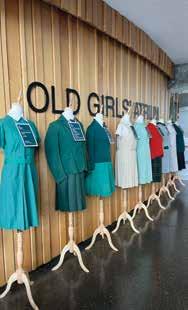

The Old Girls’ Association also provides support for the descendants of our alumnae, helping future generations access the exceptional opportunities at St Margaret’s that we, as Old Girls, continue to enjoy.
These close ties between the College and our alumnae strengthen the sense of tradition and dedication to a higher purpose that has come to define St Margaret’s.
Bella Forbes, Old Girls’ Association President
Thursday 8 May, 6:00pm
St Margaret’s College Staffroom 12 Winchester Street, Merivale
Drinks and nibbles to follow the conclusion of the meeting.

To register, visit: smcconnect.school.nz/event/smcoga-annual-general-meeting

Choosing the right school is one of the most important decisions parents make for their daughters. Beyond academic study, it is only natural to consider opportunities for leadership, wellbeing, and personal growth, along with whether a single-sex or co-educational environment will best support their child’s success.
Research shows that girls’ schools provide an environment where students thrive and are equipped to confidently step into fields traditionally dominated by men.
But what does this look like in real life? We spoke with our own James Evans and Alice Penney to explore how a girls’ education empowers St Margaret’s students to excel, find their voice, and build the confidence to take on the world.
Excelling in academics and STEM
Studies show that girls at single-sex schools outperform their peers in co-ed environments, particularly in STEM (science, technology, engineering and maths) subjects. In 2024, research of nearly 6,000 students found that girls’ school students perform better in science and maths than those in co-ed schools.
James Evans, Deputy Head of Senior School – Student Care and Experience, says that at St Margaret’s, this is evident in subject choices and student outcomes.
“When the girls reach their senior years and can choose their subjects, we see a large number opting for two sciences
and specialising early,” he explains. “They feel comfortable stepping into those spaces and know they belong there.”
This confidence translates into real-world success. A third of St Margaret’s graduates go on to study STEM subjects at university –significantly higher than national averages.
James says that at St Margaret’s, programmes are crafted with girls in mind, ensuring they remain engaged and challenged.
“In history, for example, we focus on storytelling and interpreting facts, rather than just the details of war,” says James. “This tailored approach makes learning more meaningful and relevant for our students.”
One of the standout benefits of a girls’ education is the strong sense of community. Research shows that students at girls’ schools report higher levels of support from both teachers and peers.
Year 13 student Alice Penney, Head of Drama, Head of Choir, and a member of the Arts and Wellbeing Councils, has experienced this herself.
“There’s no sense of judgment here,” she says. “Everyone is super supportive. In class, we work off each other, we ask questions, and we genuinely want everyone to do well. There’s no competition –just encouragement.”
Alice has also benefited from the leadership opportunities that come with being at a girls’ school.
“I remember when I was in Year 9, watching the senior students and how they conducted themselves. It was not as if they were better than us, but as if they were there to help,” she recalls. “Now, I get to be that role model for younger students.”
Go for it
A girls’ education not only fosters academic success but also emotional intelligence and resilience. Research indicates that girls from single-sex schools are more confident, have greater emotional control, and are less likely to engage in unhealthy behaviours than those in co-ed environments.
At St Margaret’s, the school’s structure supports this holistic development.
“All teenagers need structure and rules,” James explains, “but girls tend to need relationships first. That’s why our pastoral care system is designed the way it is – so that every girl has the support she needs to thrive.”
Alice agrees, noting that the environment at St Margaret’s has helped her grow in confidence.
“If I want to do something, there are so many people who tell me to go for it,” she says. “My parents have noticed how much more confident I’ve become.”
Will she learn to work with the guys?
A common question about single-sex education is whether students miss out on interactions with boys. However, both James and Alice say this is not a concern.
“There are plenty of opportunities to socialise with boys through sports, performing arts, and leadership days with our brother school Christ’s College,” James explains. “The girls who come back to visit never say they missed out on anything.”
Alice shares a similar perspective.
“I’ve never felt the need to be at a co-ed school to make male friends. The school provides plenty of opportunities to connect with boys who share the same interests and values as me,” she says.
She also feels confident about heading into tertiary study and eventually into the workplace.
“The communication skills and confidence I’ve gained here will help me interact with anyone, no matter who they are,” she says. “At the end of the day, people are just people.”
For parents deciding on the best school for their daughter, James offers simple advice:
“It depends on your child. But in general, girls at an all-girls school will find their tribe and thrive. It’s an incredibly supportive environment where they can excel.”
Alice has one piece of advice for younger students just starting their journey at St Margaret’s:
“Try everything. Put yourself out there. It’s such a great environment to try new things, and everyone is so supportive.”





Ten years ago, St Margaret’s welcomed its youngest learners back to campus, reviving a tradition that had been dormant for more than six decades. Now, a decade after the reopening, the preschool has flourished and become a vital part of the school community once more.
St Margaret’s history with early childhood education stretches back to its very foundations. The Kilburn sisters established the school in 1910 and, from the outset, included younger children in their vision. Their strategic decision allowed them to cultivate a pipeline of students who would progress through the upper school. When the kindergarten first opened its doors on Armagh Street, it began with just two students. By 1916, the kindergarten had expanded to include 11 girls and three boys, marking the beginning of a rich tradition of co-educational early childhood learning at St Margaret’s.
Boys attended the kindergarten between 1914 and 1941, demonstrating the school’s inclusive approach to early education. However, in 1951, the kindergarten closed, ending an era of early learning at the College. It would be another 64 years before the preschool programme returned, bringing with it a new era of educational opportunities for the youngest members of the community.
In 2015, St Margaret’s officially reopened the Preschool at Winchester Street, beginning with just six children. Since then it has grown significantly, reflecting the
demand for high-quality early childhood education within the school’s nurturing environment.
The Preschool is led by Director Sarah Bradley and a team of five dedicated teachers, including two fully primarytrained educators. This ensures that children receive the highest standard of early education while benefiting from a seamless transition into the primary years.
One of the key advantages of the Preschool is its integration with the broader school community. Young learners have access to the full range of school facilities and take part in an enriched curriculum that extends beyond traditional early childhood education. From dance and yoga to gym classes and technology sessions, students engage in diverse learning experiences that set them up for success. Additionally, the school’s structured transition-to-school programme ensures that children move confidently into their next stage of education.
Reflecting on the past ten years, it is clear that the reintroduction of a preschool has been a resounding success. It has not only re-established a key part of St Margaret’s heritage but has also provided a nurturing and enriching environment for generations of young learners.
As the College celebrates this milestone, it looks forward to continuing to grow and innovate in early childhood education. With a strong foundation, a dedicated team, and a commitment to excellence, the Preschool is set to thrive for many years to come.
As we approach the Year 1 classroom, it is evident from the huge running hug delivered by Poppy that she adores her Year 4 buddy Chriselle.
The feeling is clearly mutual, and the buddy responsibility is one that Chriselle takes very seriously.
The Year 4 class was matched with a Year 1 buddy at the beginning of the school year, and already, firm friendships have formed.
“It’s really fun being a buddy because you get to take care of the little girls. I love spending time with them, it’s the best,” says Chriselle.
Chriselle says that being a great buddy is about learning about each other.
“I really love Friday buddy time. I like teaching Poppy what she needs to know about school, like how to be organised and responsible, how to be quiet when the teacher is talking and to always speak nicely. Sometimes she teaches me new things too, and then we read a book together.
“I make sure she’s always got a friend to play with. We sometimes find one of her friends and play together on the big grassy field with my friends too.”
For Poppy, her budding friendship with Chriselle helped her overcome her first day nerves.
“I felt nervous and I was a bit scared. But after that, I didn’t want to go home anymore. The thing I love the most about school is Chriselle, because she plays with me. We play hide and seek tag but she’s not hard to find!”
Poppy is already looking forward to being a buddy herself, when she is old enough.
“I love the little two- and three-year-olds and I like to go over to the Preschool with Chriselle and see them sometimes. Today my little friend was just standing there so I went to give her a hug to make her happy,” says Poppy.
The St Margaret’s buddy programme is more than just a school tradition – it builds a special bond between our big sisters and little sisters, based on confidence, kindness, and a sense of belonging that lasts well beyond the classroom.

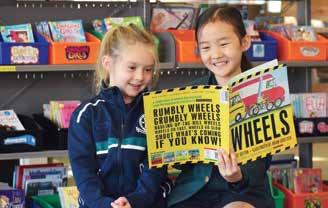

Two years after the release of ChatGPT, artificial intelligence (AI) is no longer a futuristic concept, it is here, embedded in our daily lives and, increasingly, classrooms around the world. At St Margaret’s, we recognise the immense opportunities and the complex challenges AI presents for education.
As we prepare students for a future where AI is ubiquitous in workplaces and society, our focus is on equipping them with critical AI literacy. This means understanding how AI works, evaluating its limitations and potential, and using it ethically and effectively.
In early 2024, we established an AI steering group to plan opportunities for our teaching staff to experiment, innovate and engage with these opportunities and challenges. This is helping St Margaret’s create a longterm, sustainable framework to embrace AI in education while maintaining our human centred values.
We have engaged with educational institutions around the world, at both secondary and tertiary levels, to align our strategies with best practices. The steering group has focused on three key areas:
1. Policy development: crafting guidelines for ethical AI use while addressing age restrictions, privacy concerns and risks to academic integrity.
2. Productivity enhancement: looking for ways to shift focus from administrative tasks that can be easily and accurately automated
3. Pedagogical innovation: investigating best practices to prepare students for a rapidly evolving world; ensuring that ‘fads’ are not passively adopted but are thoughtfully evaluated before use.
Professional learning for staff has included guest speakers, such as Bethanie Maples of Stanford University, an expert in AI policy, education and technology, and has encouraged a ‘play space’ approach in which St Margaret’s staff have explored the possibilities of AI in our context. Peer-to-peer workshops demonstrate successful learning design incorporating AI technologies and a number of staff this year are enrolled in a University of Canterbury short course: AI Essentials in Education. Staff who have attended conferences in New Zealand, overseas and online throughout 2023 and 2024 have also benefited from keynote speakers and workshops that calibrate our AI approach with the best practices from around the world.
These initiatives have helped our teaching team identify the advantages of AI in education; the ability to augment

and extend student capability, to access and differentiate learning, and to enhance research and problem solving skills.
However, alongside these advantages come well documented concerns. The rapid advancement of AI raises questions about academic integrity, digital literacy, and ethical use. As educators, we must ensure that students are not abdicating the development of key skills, thinking, inquiry, analysis and reflection to the quick (and not entirely fool-proof) outputs Gemini, Perplexity or any number of AI platforms readily available.
As we move from the ‘play space’ to implementation, we are also mindful of ethical, data and privacy considerations and have developed guidelines to support this. In light of the rapid development of AI, it is expected that our conversations about AI will continue over the next several years.
At St Margaret’s we are committed to ensuring that technology serves our educational goals, not the other way around. By fostering a culture of continuous learning and curiosity about AI, we aim to equip our community with the skills needed to thrive in an increasingly AI-driven world.
We are proud of our students for their outstanding academic achievements.
Consistently achieving amongst the highest academic results in New Zealand and internationally through the dual pathway of International Baccalaureate and NCEA,
St Margaret’s students have achieved the best academic results in Christchurch for the second consecutive year.
Academic results 2024
98% pass rate Level 3 NCEA (New Zealand average pass rate of 68%)
99% pass rate Level 2 NCEA (New Zealand average pass rate of 73%)
91% pass rate International Baccalaureate (global average pass rate of 72.5%)
90%+ pass rate for mandatory literacy and numeracy corequisites in Year 10
Class of 2024
Destinations
University of Otago University of Canterbury
Victoria University of Wellington
Overseas universities
Te Pūkenga | Ara Institute of Canterbury
Lincoln University
Gap year/full time employment
Otago Polytechnic University of Auckland
Massey University
Queenstown Resort College
Toi Whakaari | New Zealand School of Drama
Fields of Study
Commerce
Law
Engineering
Sciences (Health)
Sciences
Sciences (Psychological)
Sciences (Sport)
Sciences (Biomedical)
Nursing
Veterinary Nursing
Architecture
Design
Psychology
Education
Land and Property Management
Art
Music
Armed Forces
Beauty
Data Science
History
Social Work
Tourism
Viticulture

“We will find something for everyone, and we believe in all of our students.”


At St Margaret’s, drama is more than just a subject, it is a journey of creativity, collaboration, and self-discovery. Under the leadership of a strong and passionate team of educators, the drama programme has flourished into a dynamic and inclusive environment that nurtures students from the Junior School through to the Senior School.
The drama curriculum at St Margaret’s is unique in its breadth and depth. Every student in the Junior School participates in drama as part of their curriculum, ensuring that performance and creativity are ingrained in their early education. From Years 7 – 9, all students engage with the drama programme. From Year 10 and into the Senior School, girls can choose drama as an option, following either the NCEA or International Baccalaureate dual pathway. St Margaret’s has had outstanding academic results in NCEA and IB Theatre Arts, including some of the highest marks in IB Theatre Arts globally, in the top 2% of students.
With a team of 14 drama specialist teachers – specialisation happens from Years 1 – 13 in both curricular and cocurricular programmes. Hundreds of students at our school engage with drama on a daily basis.
The core philosophy behind the drama curriculum is inclusivity. “We achieve highly but in an inclusive way,” Megan Herd, Curriculum Leader of Drama, says. “We will find something for everyone, and we believe in all of our students.” This belief fosters a supportive atmosphere where students of all abilities feel empowered to explore their creative potential.
The success of the drama programme is evident in the productions that have left a lasting impact on students and teachers alike. Megan reflects on some of the most memorable moments of her career, including A Shakespearean Banquet, Alice!, and A Midsummer Night’s Dream. These productions showcased talent and
were a testament to the collaborative process that defines drama and performing arts at St Margaret’s. Students play a key role in devising and creating performances, ensuring that their unique talents and passions are highlighted.
The celebration of student achievements extends beyond the stage. St Margaret’s has a “say yes” philosophy – if a student has an idea or passion for drama, the school finds a way to make it happen.
The co-curricular opportunities for drama enthusiasts at St Margaret’s are extensive. There are performance opportunities across all school levels, including for 2025 a Junior School performance opportunity, a Middle School production, and a Senior School production.
Co-curricular drama offerings are:
• Yearly major productions
• Regional theatre sports competition
• Regional and National Shakespeare Festival
• NZ Theatre Festival Regional
• Speech and drama tuition
• Regional speech and drama competitions
• Middle School and Senior School Drama clubs,
Many students and staff perform and are involved in community theatre across Christchurch. Ruth Agnew and Megan feature in an upcoming Court Theatre show The Laramie Project, as are five students who are performing in The Court Theatre Sponge Bob and many others performing in shows across the city.
A particular highlight each year is the Sheilah Winn Shakespeare Festival, where students have excelled year after year, consistently making it to the national stage. The festival has become a source of inspiration, with younger students aspiring to follow in the footsteps of those who have performed at the prestigious Globe Theatre in London. Last year, CJ Horrey and Sophie Brownlie were among the students selected for this honour. Beyond performance, students can engage in songwriting, essay writing, costume design, directing, and leadership roles.
For Megan, the most rewarding part of teaching drama is the students and the team culture within the performing arts faculty. “It is a privilege to teach them,” she says.
Drama at St Margaret’s is more than just an academic subject – it is a community built on the values of whanaungatanga, a Māori concept encompassing family and connection. This sense of belonging gives students the confidence to step up and embrace the challenges of performance. “We work alongside the students, recognising everyone’s strengths and abilities. Everyone feels cared for and safe. That’s one of the special things about St Margaret’s,” Megan says.
Through drama, students develop not only performance skills but also confidence, leadership, and a sense of community– skills that will stay with them long after the final curtain falls.
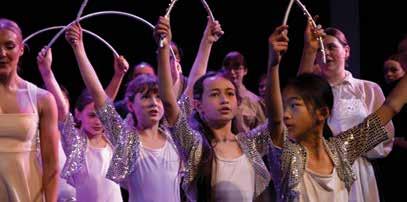




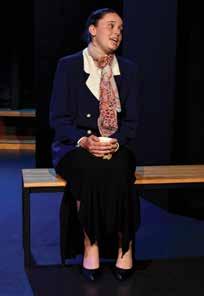



For generations, the Black Sticks have been the pinnacle of New Zealand hockey, with players donning the black jersey as they take on the world’s best. But how has the experience of being a Black Stick changed over time? We spoke with Pippa Hayward (Year 9 2004), who played in the 2010s, and Mezzy Surridge (Year 9 2018), a fresh face in the 2025 squad, to explore how the game and its demands have evolved.
Both Pippa and Mezzy describe playing for New Zealand as an immense privilege. For Pippa, it was a deeply cherished experience, made even more special by the support of friends and family in the crowd. “It was a great honour and something I will always cherish,” she recalls. “Playing alongside your friends with your family cheering you on was incredibly special.”
Mezzy echoes this sentiment but adds that representing New Zealand felt surreal. “Playing my debut felt like a dream come true. I’ve wanted this since I can remember, and to travel across the world representing my country is something I’ll always be grateful for.”
Transitioning from school and club hockey to the international stage has always been a significant leap. Pippa remembers struggling with the intensity of training. “The level of hockey was a huge step up, and it took me a while to adjust, especially the trainings, which were often harder than the games. The fitness expectations were a shock.”
For Mezzy, the biggest adjustment was the speed of play. “International hockey is fast. You don’t get as much time on the ball as you do in school or club games, so decisionmaking has to be sharp.”
Despite the challenges, both players have memorable highlights from their careers. Pippa treasures the Commonwealth Games gold medal win on the Gold Coast in 2018 and the experience of competing at the Rio Olympics in 2016. However, her greatest personal achievement was overcoming anxiety and regaining confidence in high-performance sport.
For Mezzy, scoring her first international goal in a final was a defining moment. “It was so special celebrating with my teammates. Singing the national anthem in front of a home crowd for the first time was another unforgettable experience.”
Both players emphasise resilience and dedication. Pippa advises young players to maintain self-belief: “Highperformance sport is cutthroat. You’ll be told you need to improve, and it can knock your confidence. Believe in yourself and don’t let negativity take over.”
Mezzy encourages young athletes to embrace hard work. “Train hard and love the process, not just the rewards. Setbacks should fuel your motivation to be better.”
While much has changed over the decades, the essence of being a Black Stick remains the same: hard work, resilience, and an unwavering passion for the game.

Sport is more than just competition – it’s about growth, resilience, and wellbeing. Since stepping into her newly established role late last year, Sport and Coach Developer Hannah Romano has made it her mission to ensure every student coach and athlete thrives, both on and off the field.
At St Margaret’s, girls are encouraged to be active, whether competing at the highest national and international levels or simply enjoying sport with their friends. Over 90% of girls participate in sports, choosing from more than 30 different options.
Coaching is also a big part of the school’s sporting culture, with more than 30 students volunteering as coaches in the summer terms, and even more in the winter. The school ensures they have the tools to lead, inspire, and grow within their roles.
“It’s really inspiring seeing how many of our girls want to give their time to support younger students’ growth,” says Hannah. “There is so much in it for them too, developing their communication and leadership skills while being role models for their peers.”
Hannah provides student coaches with practical tools for training sessions and game development, while


also supporting athletes’ psychological and emotional wellbeing.
“We talk about student athletes sitting on their threelegged stool – physical, emotional, and psychological. When all three are balanced, everything feels steady, but if one side gets wobbly, it can throw everything off. My job, and the school’s, is to help keep that stool strong.”
Hannah emphasises the importance of communication in maintaining balance.
“We make sure the girls understand how important it is to speak up if they’re struggling. By getting to know them better, we can create the best possible sporting pathway for them.”
Hannah believes a positive relationship with sport and fitness is a powerful tool for girls.
“The benefits reach far beyond physical fitness, reducing stress and anxiety, and building confidence. Sport helps us to learn how to handle challenges and setbacks, improves focus, grows independence, and most importantly, creates strong friendships and support networks.
“I want every player, and every coach, to be the best they can be, and come back term after term, because they have a positive relationship with sport and love the balance it brings to their lives,” says Hannah.
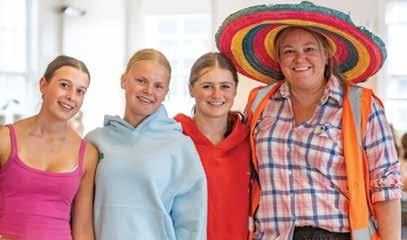
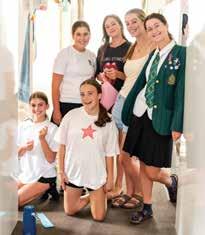


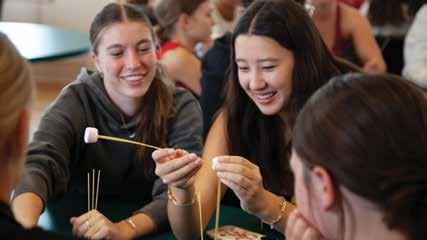

The first weekend of every school year marks a special tradition for St Margaret’s College boarders – the Boarders’ Big Weekend In. Designed to foster friendships and help new students adjust to boarding life, the weekend is packed with exciting activities that create lasting memories.
This year’s Big Weekend In kicked off with a colourful dinner. Our boarders dressed in bright hues to set the tone for a vibrant year ahead. Laughter and chatter filled the dining hall as old friends reconnected and new students felt welcomed into the community. Friday fun continued with a silent disco, where girls donned wireless headphones and danced the night away, each choosing their own music while sharing the experience together. Saturday brought a mix of adventure, skill-building, and creativity. The day began with an amazing race,
where teams raced around campus, solving clues and tackling physical and mental challenges. This was followed by a self-defence workshop, equipping boarders with confidence and important life skills. In the afternoon, students channelled their inner bakers during a cake decorating session, showcasing their artistic flair. The night concluded with a Theme Dinner, challenging the girls to dress as something beginning with the first letter of their name.
The weekend wrapped up with thrilling excursions to Ninja Valley, where the girls tested their agility on obstacle courses, and Jellie Park, where they enjoyed swimming and outdoor fun.
By the end of the Boarders Big Weekend In, friendships were formed, new students felt at home, and the boarding family is ready to take on the year together.
From teaching assistant to leadership roles, new Year 3 teacher Marisa Spear has dedicated her career to nurturing young minds. After years at St Alban’s Primary, she brought her passion for innovative education and belief in structured literacy to St Margaret’s. Marisa shares her journey, teaching philosophy, and the secrets to keeping students engaged.
Q: Can you share a bit about your teaching journey?
A: I’ve worked in schools as a teaching assistant, board of trustees member, teacher, and in leadership – all at St Alban’s School. I admired the Junior School at St Margaret’s, and after my three daughters had attended the College, I believed in its values and family feel. It felt like a natural yet challenging move.
Q: How do you keep students engaged and excited about learning?
A: At St Margaret’s there is constant innovation with programmes and a strong focus on structured literacy and numeracy. I trialled the current maths programme at St Alban’s, and it engaged even the most reluctant learners. I also emphasise a growth mindset, helping students develop positive self-talk and perseverance.
Q: What’s one lesson or activity that students always love?
A: Art. It keeps them engaged and also supports growth mindset development and fine motor skills.
Q: What’s the most rewarding part of being a teacher?
A: Building relationships with students and parents. It’s about working together to help children grow into great human beings.
Q: What’s one thing you wish people understood about teaching?
A: It’s draining. You’re “on stage” all day, investing energy into staying positive and present for the kids. It also involves a lot of behind-the-scenes work to ensure lessons are engaging and effective.
Q: If you weren’t a teacher, what career would you have pursued?
A: An accountant. I’ve always enjoyed numbers, even though my previous roles were all about building relationships.
Q: What’s a fun fact your students might not know about you?
A: I played the trumpet in jazz bands as a teenager.
Q: If you could invite any historical figure to speak to your class, who would it be and why?
A: Marie Curie, for her groundbreaking work in science and her courage as a woman in a male-dominated field. I’d love to hear about the risks she took and the mistakes she learned from.
• Coffee or tea? Coffee.

• Pineapple on pizza? No.
• Early bird or night owl? Was a night owl, but becoming an early bird.
• Sweet or savoury snacks? Savoury.
• Most-used emoji?

• Dogs or cats? Always a cat person, but currently a dog person.


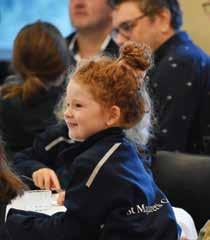










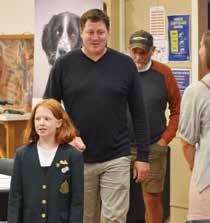





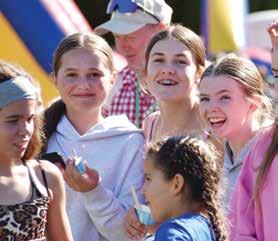
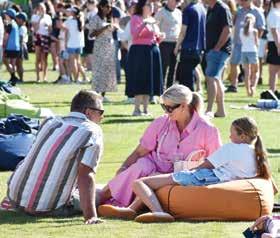




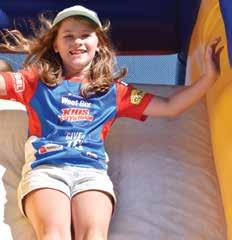


The Parents and Friends Association launched our 2025 Parent Speaker Series with renowned psychologist, parenting expert, and author Dr. Justin Coulson. His compelling presentation to parents and caregivers of daughters in Year 4–9 tackled the crucial topic of fostering a play-based childhood over a screen-based one.
Dr. Coulson offered clear, practical strategies on pressing parenting concerns – when to introduce a phone, how to manage social media, the impact of gaming and screen time, and how to build a strong community to keep our children safe. His talk was engaging, insightful, and at times confronting, leaving many parents deeply reflective about the challenges of raising children in the digital age.
One attendee shared, “Justin’s talk was informative, uncomfortable but reassuring.” Another remarked, “This session was invaluable – full of practical ideas I can start using right away.” These reactions underscore the importance of open conversations and community support as we navigate modern parenting in partnership with the College.

Learn more about the PFA and join our next meeting by visiting SMC Connect.


As a Parents and Friends Association, our goal is to create a strong, inclusive community where parents can share concerns, exchange wisdom, and support each other. There is no substitute for the reassurance of talking with a fellow parent who is facing the same challenges or has already overcome them. Through our Parent Speaker Series, twice-termly PFA meetings, and events shared with our daughters, we aim to foster these vital connections and build on the community around our children.
Our thanks to Head of Junior School, Bridget ComptonMoen and Head of Middle School Kathryn Gray for hosting this event, and taking forward this conversation with parents.
Cheryl Cordier, PFA President

Stay up to date with events and community news. Join us at smcconnect.school.nz
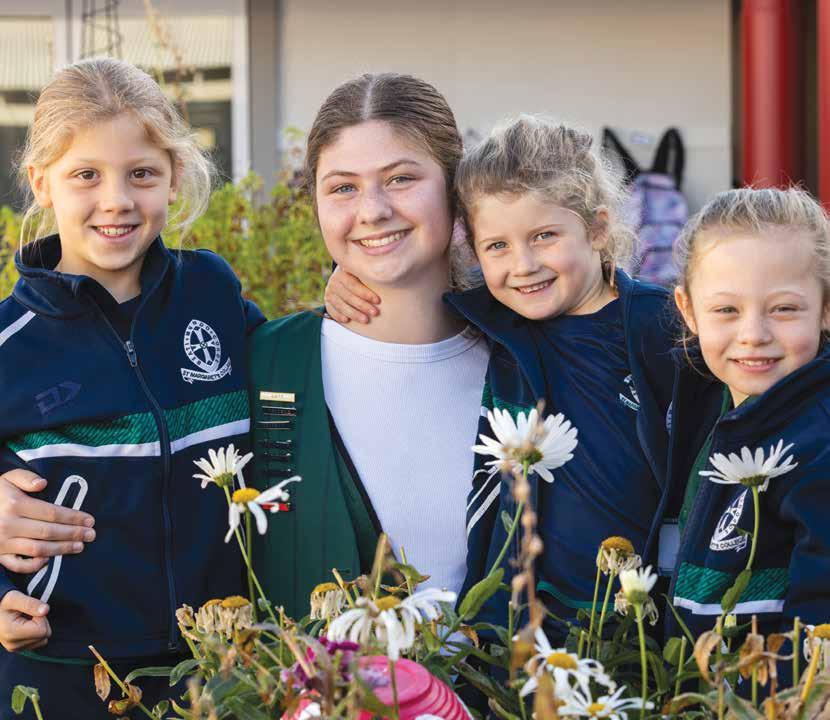
The St Margaret’s College Foundation is embarking on a transformative journey to secure the sustainability of the College for generations to come. Our Creating a Legacy for the Future campaign is the most significant philanthropic initiative in our history, designed to ensure we can continue to provide world-class opportunities for our girls.
The campaign aims to establish an enduring Endowment Fund of $10 million. This fund will provide financial stability and flexibility, enabling St Margaret’s to respond to challenges, innovate in education, and ensure accessibility for deserving students regardless of their financial circumstances.
We are thrilled to share that the campaign has already achieved an extraordinary milestone, with $2 million donated toward our goal. This remarkable start reflects the generosity and vision of our St Margaret’s community,
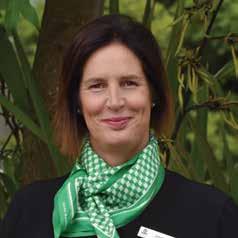

who understand the pivotal impact that this fund will have on future generations of students.
This campaign represents more than a financial target –it signals a commitment and intent to preserve the values, spirit, and aspirations that make our College unique.
We invite all members of the St Margaret’s community to join us in this vital endeavour. Together, we can create a legacy that ensures the success of future generations and honours the foundation laid by those who came before us.
If you’d like to learn more about the Creating a Legacy for the Future campaign or explore ways to contribute, I’d love to chat with you – please feel free to reach out anytime.
Erin Reeve, Foundation Manager foundation@stmargarets.school.nz
From her days as a boarding student at St Margaret’s to an exciting career in fashion, Charlotte Bush’s (Year 9 2014) journey is one of passion, adaptability, and taking bold leaps into the unknown. As she prepares for her next adventure in Melbourne, Charlotte reflects on the lessons learned at St Margaret’s and the experiences that have shaped her path.
Charlotte describes her time at school as full of friendships and opportunities. “I was a boarder, which was so fun –I made so many friends,” she recalls. Sport played a major role in her school years, with netball and touch being her chosen pursuits. Introduced to touch at St Margaret’s, Charlotte continued playing after leaving school and went on to wear the silver fern representing New Zealand while at university.
Her passion for English was nurtured by a particularly influential teacher. “Mrs. Robinson was my favourite. I didn’t realise I had dyspraxia until she picked it up from my handwriting. She said my work was great but the examiner wouldn’t understand it, so she suggested I get tested,” Charlotte explains. “That changed my university experience completely – I was able to use a laptop, which made such a difference.”
One of her most cherished memories is from her final year, living in the ‘Dolls House’ part of the Year 13 Cranmer apartments. “There were five of us all roomed together for the whole year, it set me up for university, living with sisters I had grown up with.”
After leaving school, Charlotte pursued a degree in psychology at the University of Canterbury. “I loved it–it was fascinating to understand how people work and why they do the things they do,” she says. After four years, she graduated with Honours.
Her passion for fashion led her to her current role as a Purchasing Assistant at J Ballantyne & Co. “I’ve always been interested in fashion, so I thought, why not use the skills I learned at uni – like statistics and understanding people – and apply them to a fashion job?” she explains. Working closely with buyers, Charlotte ensures orders are coded correctly and arrive on time.
One of the most exciting aspects of her job has been working at fashion shows and photo shoots. “I love styling models and creating content. I even got to help style the Christmas magazine,” she shares. “And, of course, I get to see the latest trends before they hit the stores – and I get a discount!”
Charlotte is about to embark on a new chapter, moving to Melbourne without a job lined up but with big aspirations.

“It’s a new experience, a big adventure – I’m taking a leap,” she says. She’s particularly interested in staying within the fashion industry and exploring work as a wedding stylist and celebrant. “I recently became a marriage celebrant, and I’d love to work with a wedding planner. The idea came to me while helping a good friend plan her wedding – someone I boarded with; I’ll be her celebrant in January 2026.”
Charlotte is certain when asked if she sees herself returning to New Zealand. “Absolutely – Christchurch is the perfect place to raise a family.” Charlotte’s grandmother, Nicola Warren (Year 9 1951), is an Old Girl, as are her sisters, Harriet (Year 9 2013) and Rebecca (Year 9 2011), and the girls’ mother, Fiona, taught at St Margaret’s, so her family ties here are strong.
With a fearless attitude and an open mind, Charlotte is ready to embrace the unknown, confident that her journey will lead her exactly where she’s meant to be.


Most weekends, you’ll find Vanessa Martin (Year 9 2013) on the sports field – not as a player, but as the person responsible for ensuring live broadcasts run seamlessly. As a field technician and broadcast engineer, Vanessa is in charge of setting up the equipment that beams that crucial All Blacks game straight into your living room.
Vanessa is also the one who fixes things when they go wrong. “Part of my role is problem-solving, and to do that effectively involves a lot of planning and collaboration –with both a Plan A and a Plan B. It’s so rewarding when you can solve your own issues or take a piece of equipment apart and succeed in getting it back together and working.”
Vanessa has always loved the fast-paced, live nature of television. “That’s what drew me to this field,” she says. “I’ve always been interested in radio and TV, especially when presenters would talk about their producers and what happens behind the scenes. I knew I didn’t want to be in front of the mic or the camera – I wanted to be the one making it all happen.”
Her role takes her across New Zealand and the Pacific Islands, often travelling to three or four cities in a single week. While the travel can make it challenging to catch up with friends, Vanessa thrives on the experience.
A self-described ‘techy,’ Vanessa’s interest in technology started early, and she was Head of the Technical team at St Margaret’s. She pursued a Bachelor of Broadcasting Communications, majoring in Screen and TV Production at Ara, where she was one of just 25 students accepted into the course. Part of her studies included a six-month internship with OSB and Sky NZ, which she completed partly from home due to COVID restrictions.
Vanessa’s first job after graduating was with NEP Broadcast Services (the global production company she works for today), where she spent a year working in a hot, dark studio covering horse racing for the TAB. That experience made her realise she much preferred working outdoors. Despite working in sports broadcasting, Vanessa doesn’t enjoy watching sport. Her passion lies in her work, ensuring each broadcast is executed flawlessly.
Working in a male-dominated industry, Vanessa has encountered challenges. “There have been times when my professional advice was not taken on board,” she says. “In those situations, you have to stand up for yourself – don’t let anyone walk over you.”
Next on her agenda is the New Zealand Open in Queenstown. “Golf is one of the hardest sports to film because it covers such a vast area. We’ll be using over 25km of cables, and multiple cameras.”
Despite shifts in the media landscape, Vanessa believes live sports broadcasting will always be in demand. “While we’ve seen a reduction in the number of reality TV shows being produced, more and more sports are being televised, which means plenty of opportunities in this industry.”
Her advice for students interested in the industry?
“Seek out opportunities – there are so many in Christchurch. I worked at the Court Theatre to gain experience, and there are internships with radio stations and even making your own films.”
Reflecting on her time at St Margaret’s, Vanessa credits the school with shaping her work ethic. “St Margaret’s taught me how to work independently and as part of a team, and to have initiative. Those skills help you stand out in this industry.”
Sophie Hartnell’s (Year 9 1989) passion for conservation is deeply rooted in her connection to the land through the work she does with Te Kākahu Kahukura, a voluntary initiative focused on restoring native forests on the Port Hills. This landowner-driven project, facilitated by the Banks Peninsula Conservation Trust, is making significant strides in regenerating Te Pātaka o Rākaihautū/Banks Peninsula lost bushland.
Te Kākahu Kahukura was started after the 2017 Port Hills fire, which destroyed large areas of native bushland. Since 2021, Sophie has been at the forefront of this initiative, working with private landowners, local agencies, and businesses to rebuild what was lost and strengthen ecological connections between existing plantings.
“The New Zealand natural environment means a lot to me,” says Sophie. “I feel a deep affinity with it and want to conserve it. Spending so much time in nature, both for work and in my spare time, you start to see how interconnected everything is. Knowing what’s at risk if we don’t act now is what drives me.”
Before the Banks Peninsula Conservation Trust was established in 2001, less than 1% of native planting remained on the peninsula. The trust is the only independent organisation able to covenant land, allowing landowners to protect areas of ecological significance on their own terms. Some properties have as many as three covenants, ranging from five to 300 hectares. By joining the dots between these protected areas, Te Kākahu Kahukura is creating a more resilient landscape that will benefit future generations.
“Our original goal was to plant 10,000 trees in five years, but we’ve realised it’s going to take longer – we’ll likely reach our target in 2028,” Sophie explains. “An ecologist advised us that certain tree species were missing from the southern Port Hills, and we’ve been working to restore those gaps.”
Collaboration is at the heart of this initiative. Te Kākahu Kahukura has 21 signatories, bringing together mana whenua, agencies, landowners and conservation organisations to share knowledge and resources. Workshops and events educate people about fire preparedness and restoration techniques, ensuring that conservation efforts are both practical and sustainable. Agencies, private donors and community organisations also play a crucial role by providing financial support, making these large-scale projects possible.
Sophie’s commitment to environmental restoration extends beyond her current work – she is also pursuing


postgraduate studies in ecology and conservation. Her personal four-year plan includes qualifying to be able to conduct botanical surveys and ecological fieldwork, further strengthening her impact on New Zealand’s landscapes.
For current St Margaret’s students who want to make a difference, Sophie’s advice is simple: “It’s about living with purpose. You can struggle with what’s happening in the world, but if you believe you can make a positive impact, it’s incredibly meaningful. That’s what gives me purpose.”
Through her work with Te Kākahu Kahukura, Sophie Hartnell is not just restoring forests – she’s helping to shape a more sustainable future for Banks Peninsula, Waitaha/Canterbury and beyond.
Education has the power to shape generations, and meeting Nola McLean and her daughter Dorothy Stewart was proof of this force for good. Nola (née Vile) earned a bursary to St Margaret’s in 1942 from Shirley Intermediate School. Biking each morning from Avonside, Nola embraced all aspects of the College—pressing her tussore every evening, playing tennis and hockey, singing in the choir, and making friends for life.
Nola trained as a teacher and was on the staff for some time as a relief teacher in 1950.
Nola’s family was grateful for the opportunities afforded to their daughter. The education she received prompted her parents to send her two younger sisters (Jocelyn Stokes and Denise Sheat) to St Margaret’s as well. The tradition of empowering women carried on through Nola and her sisters, with as many as 12 relations attending the College during Nola’s daughter Dorothy’s (née McLean, Year 9 1969) time. Nola’s granddaughters, Kirsty Moore (née Stewart, Year 9 2002) and Susannah Stewart (Year 9 2005) also attended.
While forming lifelong friendships with fellow students, Nola also recalls many of her teachers and talks about their lasting impact on her. English with Miss Margaret Dalziel, who went on to become Chancellor of the University of Otago; Miss Griffin, a brilliant teacher who taught Latin and married Mr Foster Brown, the cathedral church organist and choirmaster; Miss Parr for Maths; Miss Lesley Anderson for French and Miss King for Gym. Miss King was so passionate about Phyisical Education (PE) that she started training school leavers from throughout the South Island to be PE teachers. Nola recalls as many as eight student teachers were trained at St Margaret’s before the opening of the PE school at the University of Otago. Miss Claughton was a wonderful Choir Mistress teaching classical anthems, and Miss Cadel, who had an English university hockey blue took over PE in 1946.
Under the guise of Mrs Young, strict routine and an emphasis on divinity took the girls at Cranmer Square through the war years. Nola recalls the girls from the Chatham Islands having a tough time, all not returning to their homes or seeing their parents for five years. “As new girls, we all had to partake in an ‘intelligence’ test once a week, reciting the school motto but also naming all of the streets in central Christchurch in order, particularly hard if you hadn’t grown up in the city. This was to earn house points”
With spare time after school, the girls would visit a war effort organisation on Cashel Street, where they made camouflage nets. They had air raid trials, crossing over to Hagley Park bunkers.

The girls had a sound Anglican education with divinity lessons daily, choir and chapel services, and walking croc style to the Cathedral every afternoon during holy week. Nola is still now drawn to think of school on a Tuesday morning, “Every Tuesday at 9.00am we knelt to pray for our school, our homes and our Old Girls. Mrs Young assured us on leaving that we could know that we were being prayed for on Tuesday mornings.” Looking back, Nola did wonder if they were praying for her at that time. The girls studied for school certificate over four years compared to three from their comparable schools, which, from the early days, embedded the special character and tradition of a St Margaret’s education.
Now heading towards a fourth generation of girls to attend St Margaret’s, Nola’s first great-granddaughter is enrolled for a 2032 start, bringing the family almost to a full century of association. Hearing Nola and Dorothy’s stories was an absolute pleasure, with far too many to share in just one page.


“When in about 20 years time our meetings leave the happy family gatherings stage, we shall need your mature judgement and loyal support in establishing an Old Girls’ Association capable of binding the past and the present in unity and strength.”
Sister Winifred 1913
The history of our alumnae association
“When in about 20 years time our meetings leave the happy family gatherings stage, we shall need your mature judgement and loyal support in establishing an Old Girls’ Association capable of binding the past and the present in unity and strength.” Sister Winifred 1913
For 115 years, generations of young women have stepped through the gates of St Margaret’s, each one becoming part of a legacy of strong, supportive alumnae.
The first Old Girls’ meeting in 1913, organised by Sister Winifred, the College’s first Headmistress, marked the beginning of a lifelong connection. They gathered regularly and, in keeping with the College’s founding value of dedication to a higher purpose, contributed to the missionary bazaar and hosted cultural events.
In 1916, Sister Nancy formally established the St Margaret’s College Old Girls’ Association (SMCOGA). A committee was formed, rules were drafted, and activities were planned, including support for the Red Cross.
The first reunion was held in 1922, featuring an Annual General Meeting (AGM) and a dance in the school hall. Today, one of the most cherished traditions for our alumnae is opening their time capsule – filled with memories from their Year 13 – ten years after graduating, before gathering for their first reunion five years later.
In 1930, Janet Storry, a former day student, was appointed as the Association’s first President. With this, the Old Girls’ blazer was introduced – cream with a silver badge and dark saxe lettering and cord. In 1939, a new light green blazer was introduced, featuring silver monogrammed
pockets and nickel-plated buttons with the school badge in relief. The previous year’s Head Prefect still wears this blazer today at the College’s Annual Founders’ Day service.
To help others experience the gift of a St Margaret’s education, the Old Girls’ Scholarship Fund was established in 1937, followed by the Endowment Fund in 1942, ensuring ongoing financial support for the College. Scholarships have taken a number of formats, and today, the Association offers a scholarship for the daughters of alumnae in Year 12 and 13.
The Association has also provided support for the campus, providing money for the Library (as well as book plates and furniture) and the Assembly Hall for the new school at Shrewsbury Street in 1959. When the College needed support following the earthquakes in 2012, our alumnae answered the call, coming together to raise over $300,000 in conjunction with the St Margaret’s College Foundation’s Phoenix Campaign. Their generosity and love for St Margaret’s helped realise the Old Girls’ Atrium. In 2019, the campus was further enhanced with the consecration of St Mark’s Chapel, a 115-year-old church donated by alumna Gina Satterthwaite.
Today, SMCOGA’s mission is to “Nurture connections –past, present, and future.” From mentoring students to attending reunions with lifelong friends to enrolling their own daughters – our alumnae remain a key part of the St Margaret’s family. Over 150 current students are alumnae descendants, with a growing number representing the fifth generation of their family to attend the College.
At last year’s Reunion Weekend, the class of 2004 told us the story of the beginnings of Maggie Bear. Alice Faull was unable to attend her reunion but took the time to record Maggie’s life and times:
“A lot has changed at St Margaret’s since our final year in 2008, but one constant has remained through it all: Maggie the Bear.
As members of the 2008 graduating class, we’ve watched with pride as Maggie’s role in the school grew beyond anything we could have imagined. Maggie has taken on a life of her own under the school’s care.
A mascot is born
In January 2008, before the school year kicked off, Catie (Murray) and I had the opportunity to attend a leadership course in Perth. We shared ideas, discussed our plans for the year ahead, and learned from each other’s experiences. During one of these discussions, we noticed that many other schools had adopted a yearly theme – something St Margaret’s hadn’t done recently. Inspired by this idea, we decided to introduce a theme for 2008: “Celebrate 2008”.
Our goal was to foster positivity and gratitude while also warmly welcoming our new Principal, Gillian Simpson. To bring this theme to life, we brainstormed a few fun initiatives, among these was the idea of a school mascot.
The search for the perfect mascot
The process of choosing the mascot was, in itself, a fun adventure. We went through a variety of ideas, each more outlandish than the last: “Kevin the Octopus? Marge the Magpie? Annie the Eagle?”
We decided that our mascot should be a female character who could appeal to everyone from the youngest junior schoolers to the oldest seniors. And despite all our imagination, I was adamant – she had to be a bear and be called Maggie. And so, Maggie Bear was born.
We found a costume at a party hire shop on Papanui Road that specialised in custom orders from overseas. Armed with a picture of what Maggie would look like and a budget, we pitched the idea to the girls in our year. It was a gift from the girls, to the girls.
The unveiling of Maggie Catie and I couldn’t wait to reveal Maggie when the costume arrived. We chose a Friday morning prefect meeting for the big reveal and held it at our favourite breakfast spot –Merivale McDonald’s.
After pulling Maggie from the boot of my car and changing into the suit in the McDonald’s parking lot, we made our grand entrance. But, as it turned out, there were a few quirks about Maggie that we hadn’t quite anticipated.

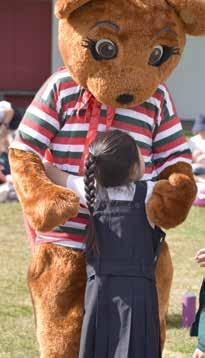
First of all, Maggie was huge. At 17, we’d mistakenly chosen the largest size, thinking that mascots were supposed to be larger-than-life, but we hadn’t considered that the average height of our year group was probably closer to 5ft 2. Even at 5ft 7, I found myself swimming in Maggie’s oversized suit, especially around the ankles, and required a helping hand from Catie.
Maggie’s head, too, was enormous. You had to tilt her head downward to see out of the eye holes, giving her a somewhat bashful, perpetually shy look. Not exactly the most intimidating or inspiring figure! This was all too evident when we met Ms Wyeth that morning. She greeted us with her usual positivity, and, overcome with enthusiasm, I went in for a hug – completely missing the breakfast tray she was holding. Unfortunately, my embrace sent freshly squeezed orange juice onto her lovely white shirt. To this day, I’m deeply sorry for that!
Maggie’s enduring spirit
We had big plans for Maggie, including custom outfits to fit her for various sports events, but I’m told that Maggie underwent a few repairs over the years, particularly after suffering trench foot from muddy winter sports games.
2024 was 20 years on from our third form year, with our recent reunion weekend taking place at St Margaret’s. I couldn’t attend the weekend due to work commitments. Still, I was delighted to see a photo of Maggie’s new look, with the original costume (affectionately labelled “Saggy Maggie”) retiring to allow her younger model to take up the mantle.
While the costume may have needed an update, Maggie’s spirit has endured. She continues to represent the fun, community spirit, and camaraderie of St Margaret’s. It’s a testament to the school community, which has nurtured everything Maggie represents, that the joy and pride she brings to the school is as strong as ever.”
Alice Faull was Head Girl in 2008. She has since worked as a Communications and Marketing Manager in education for over ten years and is currently based in Melbourne, Australia.
1419
Margaret Trolove (Nelson)
1468 Elizabeth Mary Cooke (McKenzie)
Jocelyn McKenzie (Stewart)
1656 Jean Speight (Gordon)
Jennifer Warren (Brown)
Rosalind Buddo (Roy-Smith)
Diana Brokenshire (Roberston)
Beverley Down
Thelma Hall (Gray)
2011 Patricia Bierwirth (Roberts)
2050 Gillian Anderson (Latter) (Le Clerc)
(Stevens)
Rosemary Innes-Jones (MacDonald)
Margaret Stothart (Boleyn)
Rosemary Stewart (Smith)
Beverley Paterson (Johns)
Maureen Baynes (Goddard)
Falloon (Skjellerup)
Morrah (Isaac)
Cambridge (Dorman)
Rosemary Ferguson (Wiffen)
Stella Milsom (Monk)
Jannette MacGregor (Tillson)
7964 Sarah Jones (Bowles)


Dr Roger Monk, a remarkable philanthropist whose generosity has left a lasting impact on generations of students, passed away recently at home. Roger dedicated himself to supporting girls’ education.
A passionate advocate for learning, Roger’s connection to St Margaret’s was deeply personal. His daughters, Stella Milsom and Phillipa McCrostie, both received their education at St Margaret’s, and he remained committed to paying forward the opportunities they had received. Through his unwavering generosity, he contributed a substantial amount towards scholarships.
“Roger was an essential part of the St Margaret’s community, deeply committed to supporting girls’ education through scholarships – a reflection of his dedication to the opportunities his own daughters received,” said Erin Reeve, Foundation Manager. “He was a cherished friend and will be greatly missed by all of us here at St Margaret’s.”
Roger’s passing marks the end of a chapter, but his legacy will live on in the lives he has touched and the bright futures he has helped shape. He is survived by his wife, Gwen, who shared in his passion for education and generosity.
The entire St Margaret’s community extends its deepest sympathies to Gwen and all who knew and loved Roger. His kindness, commitment, and unwavering belief in the power of education will never be forgotten.
Thursday 22 May
Wednesday 28 May
Wednesday 9 July
Friday 26 September
Friday 7 – Sunday 9 November
Wednesday 26 November
Friday 28 November
Thursday 4 December
Combined Schools’ Bridge Tournament
Auckland Margaritas combines with CCOBA
Wellington Margaritas combines with CCOBA
Combined Schools’ Golf Tournament
Reunion Weekend
Christchurch Margaritas
Time Capsule Opening, Leavers of 2015
Year 13 Leavers’ Ball
To stay up to date and register for our events, visit smcconnect.school.nz/events
At St Margarets, service isn’t just something we do –it’s who we are. Giving back is woven into the fabric of our school community from the very beginning as an outworking of our Christian faith, shaping students into compassionate leaders who make a real difference.
Each year, we come together for initiatives like the City Mission Christmas Appeal, ensuring local families in need have food at one of the most challenging times of the year. During Lent, our Lenten Appeal supports our Anglican Mission Charity, which channels generosity towards worthy causes. Our support extends beyond our gates through partnerships with organisations like The Fife Foundation, Christchurch Aunties, UNICEF and many more.
Service takes many forms, from environmental efforts like tree planting to school-wide fundraising through to events like Pyjama Day. Our students also step up by joining groups such as the Student Volunteer Army to help those in need.
But giving back isn’t just about large-scale events – it happens daily within our school. The relationship between big sisters and little sisters and peer support ensure students feel connected and supported. Whether coaching a younger team, mentoring a peer, or simply lending a hand, our students live out the values of kindness and service.
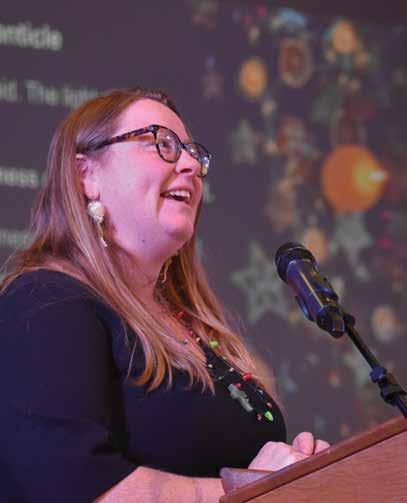
Through these acts – big and small – we build a culture where service isn’t an obligation; it is as natural as breathing. By working together, we show that making a difference is part of who we are.
Blessings and aroha, Rev. Steph Clay, Chaplain



The Lexus LBX MORIZO RR combines performance and luxury with a 1.6 litre, 206kW turbocharged engine, all-wheel drive, and an eight-speed automatic transmission. Developed alongside Master Driver Akio Toyoda, it features sport-tuned suspension, forged wheels, and an exclusive interior.
A fusion of Lexus luxury and pure driving excitement, the Lexus LBX MORIZO RR is designed for those who demand both speed and sophistication.



